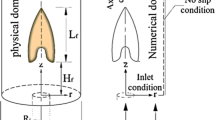Abstract
The behavior of lean premixed methane-air open V-flames of wrinkled flame fronts was studied both numerically and experimentally. In the numerical simulation, the mean flow fields of the flames were investigated when gravity was switched on and off to see the buoyancy influence on velocity and flame stretch. The results show that buoyancy accelerates the upward motion of the hot product plumes and hence changes the flow field. However, the changes are mainly concentrated in the far field area and not apparent in the area near flame brushes. The mean stretch of the flame brushes does change under the influence of gravity, but it seems that this does not influence the flame brushes strongly since the stretch rate is rather low. The experiments were done in the Bremen drop tower and the flame wrinkles were observed under both 1g0 and µg by using OH-PLIF. It can be clearly seen that the flame wrinkles were augmented under µg especially in the cases of weak turbulence. Thickness of the flame brushes was calculated according to the iso-lines of mean progress variable ē in order to see the buoyancy influence on the flame wrinkles. It was found that the impact of buoyancy is inversely related to the intensity of turbulence. The two possible mechanisms of the buoyancy influence on flame wrinkles, baroclinic mechanism and the impact of mean stretch, are discussed according to the numerical and experimental results. It seems that baroclinic mechanism is the controlling factor.
Similar content being viewed by others
References
Markstein, G. H. (Ed.): Nonsteady Flame Propagation. Pergamon Press, 1964
Aldredge, R. C. andWilliams, F. A.: Influence of Wrinkled Premixed-flame Dynamics on Large-scale, Low-intensity Turbulent Flow. Journal of Fluid Mechanics, 228: 487 (1991)
Libby, P. A.: Theoretical Analysis of the Effect of Gravity on Premixed Turbulent Flames. Combustion Science and Technology, 68:15 (1989)
Sinibaldi, J. O., Mueller, C. J., Tulkki, A. E., andDriscoll, J. F.: Suppression of Flame Wrinkling by Buoyancy: The Baroclinic Stabilization Mechanism. AIAA Journal, vol. 36, no. 8: 1432 (1998)
Kostiuk, L. W. andCheng, R. K.: The Coupling of Conical Wrinkled Laminar Flames with Gravity. Combustion and Flame, 103: 27 (1995)
Cheng, R. K. andBédat, B.: Effects of Buoyancy on Lean Premixed V-fla mes Part I: Laminar and Turbulent Flame Structures. Combustion and Flame, 116: 360 (1999)
Bray, K. N. C. andMoss, J. B.: A Unified Statistical Model of the Premixed Turbulent Flame. Acta Astronautica, 4: 291 (1977)
Peters, N.: Laminar Flamelet Concepts in Turbulent Combustion. In 21th Symposium (International) on Combustion, The Combustion Institute, Pittsburgh, p. 1231 (1986)
Wang, Y., Lei, Y., Zhang, X., Hu, W., König, J., Hinrichs, O., Eigenbrod, Ch., andRath, H.: Buoyancy Influence on Wrinkled Premixed V-flames. Microgravity Science and Technology, XIII/1: 8, (2001)
Eigenbrod, Ch., König, J., Bolik, T., Renken, H., andRath, H. J.: First Results from Non-intrusive Laser Diagnostic System for Combustion Research at Bremen Drop Tower. Microgravity Science and Technology, VIII/2: 134, (1995)
Karlovitz, B, Denniston, Jr., D. W., Knapschaefer, D. H. and Wells, F. E.: Studies on Turbulent Flames A. Flame Propagation across Velocity Gradients. In 4th Symposium (International) on Combustion, Williams & Wilkins, p. 613 (1953)
Bédat, B. andCheng, R. K.: Effects of Buoyancy on Premixed Flame Stabilization. Combustion and Flame, 107: 13–26 (1996)
Karlovitz, B.: Open Turbulent Flames. In 4th Symposium (International) on Combustion, Williams & Wilkins, p. 60 (1953)
Goix, P., Paranthoen, P., andTrinite, M.:A Tomographic Study of Measurements in a V-Shaped H2-Air Flame and a Lagrangian Interpretation of the Turbulent Flame Brush Evolution. Combustion and Flame, 81: 229 (1990)
Author information
Authors and Affiliations
Rights and permissions
About this article
Cite this article
Wang, Y., König, J. & Eigenbrod, C. Effects of buoyancy on open turbulent lean premixed methane-air V-flames. Microgravity Sci. Technol 14, 25–37 (2003). https://doi.org/10.1007/BF02870941
Received:
Accepted:
Issue Date:
DOI: https://doi.org/10.1007/BF02870941




